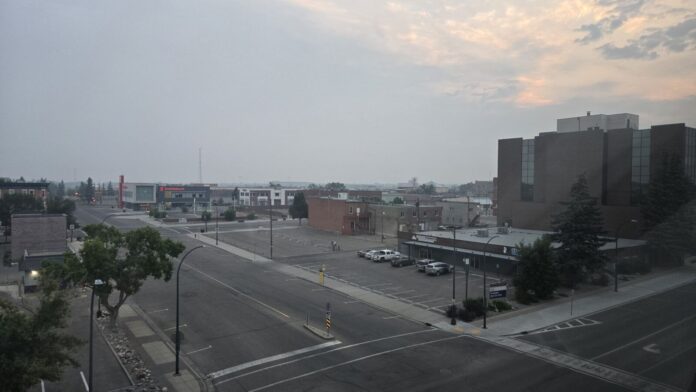Smoke that is causing issues for many parts of Alberta and parts of southern Saskatchewan is coming from wildfires in northern Alberta and parts of northeastern British Colombia according to an Environment and Climate Change Canada Scientist.
Christy Climenhagea says a large plume of smoke has settled over the region impacting a large part of the western prairies, resulting in poor air quality advisories and warnings. She says the best way to keep people safe during this time is to make sure they are staying out of the smoke as much as possible; especially seniors, infants, young children, pregnant women and those with pre-existing lung or heart conditions who are considered to be more at risk.
“Keeping the air in your house as clean as possible by keeping windows shut and avoiding using fans that pull in external air, things like those bathroom fans that can vent air in from outside is important,” Climenhagea says. “You know, those milder symptoms of a cough or a headache, those are something that we may see a little more widespread in the population, but monitoring those who are at higher risk and your own symptoms is really important as we deal with this round of poor air quality.”
Climenhagea says a bit of help from Mother Nature on Thursday should bring some relief to southern Alberta, with precipitation and a shift in the wind forecast for much of the province, including the possibility of thunderstorms in the Foothills.
“More rainfall doesn’t always flush out the smoke immediately, you could see some poor air quality just as that rain gets going and things start to get pulled down from the atmosphere, but it does look like by the time we reach Friday, we will see a more widespread relief from this smoke, but of course with air quality, it can change very quickly, so something to monitor for the next few days.”
She adds this rain is good news for the fires currently burning in Alberta.
Air quality is something she says Environment Canada will be evaluating continuously throughout the summer with the wildfire season being extremely active and the rest of the season expected to be warmer than usual.
“We do generally have a more unsettled pattern for the next little while in terms of, you know, more showery weather on and off as opposed to very long dry stretches of heat in that region into parts of central and northern Alberta.”
“When we’re long-range forecasting for our summer, we’re generally looking at patterns. It won’t give you more details on that day-to-day weather, but it does indicate a generally warmer summer.”
Climenhagea says this could mean some areas could see a long heat wave or extended stretches of warmer temperatures, but at the moment it is unknown. However, the risk of smoke and impacted air quality is top of mind with dry and hot conditions increasing the risk of fire.







